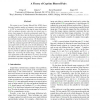Free Online Productivity Tools
i2Speak
i2Symbol
i2OCR
iTex2Img
iWeb2Print
iWeb2Shot
i2Type
iPdf2Split
iPdf2Merge
i2Bopomofo
i2Arabic
i2Style
i2Image
i2PDF
iLatex2Rtf
Sci2ools
122
click to vote
ICCV
2011
IEEE
2011
IEEE
A Theory of Coprime Blurred Pairs
We present a new Coprime Blurred Pair (CBP) theory that may benefit a number of computer vision applications. A CBP is constructed by blurring the same latent image with two unknown kernels, where the two kernels are coprime when mapped to bivariate polynomials under the ztransform. We first show that the blurred contents in a CBP are difficult to restore using conventional blind deconvolution methods based on sparsity priors. We therefore introduce a new coprime prior for recovering the latent image in a CBP. Our solution maps the CBP to bivariate polynomials and sample them on the unit circle in both dimension. We show that coprimality can be derived in terms of the rank of the B´ezout Matrix [2] formed by the sampled polynomials and we present an efficient algorithm to factor the B´ezout Matrix for recovering the latent image. Finally, we discuss applications of the CBP theory in privacy-preserving surveillance and motion deblurring, as well as physical implementations of CBP...
Computer Vision | Computer Vision Applications | Deconvolution Methods | ICCV 2011 | Physical Implementations |
| Added | 11 Dec 2011 |
| Updated | 11 Dec 2011 |
| Type | Journal |
| Year | 2011 |
| Where | ICCV |
| Authors | Feng Li, Zijia Li, David Saunders, Jingyi Yu |
Comments (0)

